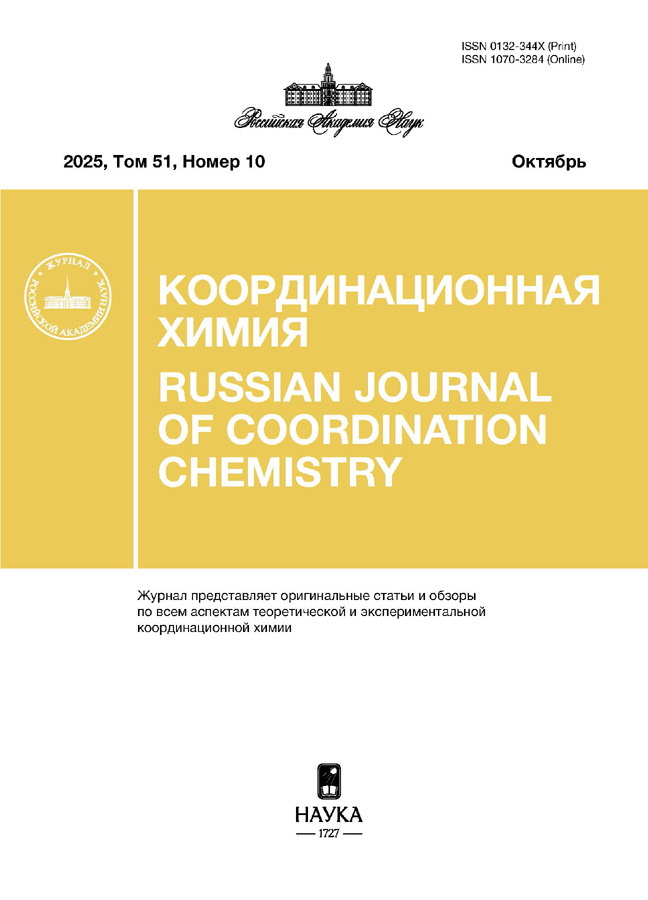Template Synthesis of the Iron(III) Complex with the Ligands Based on Acylpyrazolonepyridines
- Authors: Strunin D.D.1,2, Nikovskii I.A.1, Dan´shina A.A.1,3, Nelyubina Y.V.1
-
Affiliations:
- Nesmeyanov Institute of Organoelement Compounds, Russian Academy of Sciences
- Moscow State University
- Moscow Institute of Physics and Technology (National Research University)
- Issue: Vol 50, No 7 (2024)
- Pages: 429-437
- Section: Articles
- URL: https://gynecology.orscience.ru/0132-344X/article/view/667586
- DOI: https://doi.org/10.31857/S0132344X24070028
- EDN: https://elibrary.ru/MUQKDT
- ID: 667586
Cite item
Abstract
The reaction of new bidentate ligand, 1-(5-hydroxy-1-methyl-3-(pyridin-2-yl)-1Н-pyrazol-4-yl)ethan-1-one (L), with iron(III) chloride affords the mononuclear iron(III) complex FeL₂Cl₃, which is characterized by XRD (CIF file CCDC no. 2309481). The intramolecular hydrogen bond between the protonated pyridyl and acetyl groups in ligand L, which exists in the crystal as a zwitterion, provides the formation of rarely met iron complexes in which the β-diketonate fragment coordinates via the η1 mode. A similar coordination mode along with a possibility of a more favorable η2 coordination provides new possibilities for the design of heteropolynuclear compounds of various structures used in the fabrication of molecular devices of data storage and processing.
Full Text
About the authors
D. D. Strunin
Nesmeyanov Institute of Organoelement Compounds, Russian Academy of Sciences; Moscow State University
Email: igornikovskiy@mail.ru
Russian Federation, Moscow; Moscow
I. A. Nikovskii
Nesmeyanov Institute of Organoelement Compounds, Russian Academy of Sciences
Author for correspondence.
Email: igornikovskiy@mail.ru
Russian Federation, Moscow
A. A. Dan´shina
Nesmeyanov Institute of Organoelement Compounds, Russian Academy of Sciences; Moscow Institute of Physics and Technology (National Research University)
Email: igornikovskiy@mail.ru
Russian Federation, Moscow; Dolgoprudnyi, Moscow oblast
Yu. V. Nelyubina
Nesmeyanov Institute of Organoelement Compounds, Russian Academy of Sciences
Email: igornikovskiy@mail.ru
Russian Federation, Moscow
References
- Sato O. // Nat. Chem. 2016. V. 8. P. 644. https://doi.org/10.1038/nchem.2547
- Sun Y., Rogers J. A. // Adv. Mat. 2007. V. 19. № 15. P. 1987. https://doi.org/10.1002/adma.200602223
- Mitzi D.B., Chondroudis K., Kagan C.R. // IBM J. Res. Dev. 2001. V. 45. № 1. P. 29. https://doi.org/10.1147/rd.451.0029
- Evangelio E., Ruiz-Molina D. // J. Eur. Inorg. Chem. 2005. V. 2005. № 15. P. 2957. https://doi.org/10.1002/ejic.200500323
- Tezgerevska T. Rousset E., Gable R.W. et al. // Dalton Trans. 2019. V. 48. № 31. P. 11674. https://doi.org/10.1039/C9DT02372K
- Calzolari A., Chen Y., Lewis G.F. et al. // J. Phys. Chem. B. 2012. V. 116. P. 13141. https://doi.org/10.1021/jp3099895
- Senthil Kumar K., Ruben M. // Coord. Chem. Rev. 2017. V. 346. № 1. P.176. https://doi.org/10.1016/j.ccr.2017.03.024
- Hogue R.W., Singh S., Brooker S. // Chem. Soc. Rev. 2018. V. 47. № 19. P. 7303. https://doi.org/10.1039/C7CS00835J
- Vieru V., Pasatoiu T.D., Ungur L. et al. // Inorg. Chem. 2016. V. 55. № 19. P. 12158. https://doi.org/10.1021/acs.inorgchem.6b01669
- Yamaguchi T., Sunatsuki Y., Ishida H., et al. // Inorg. Chem. 2008. V. 47. № 13. P. 5736. https://doi.org/10.1021/ic8000575
- Bala S., Bishwas M.S., Pramanik B. et al. // Inorg. Chem. 2015. V. 54. № 17. P. 8197. https://doi.org/10.1021/acs.inorgchem.5b00334
- Vujkovic N., César V., Lugan N., et al. // Chem. — Eur. J. 2011. V. 17. № 47. P. 13151. https://doi.org/10.1002/chem.201102767
- Cingolani A., Marchetti,F.. Pettinari C. et al. // Polyhedron 2006. V. 25. № 1. P. 124. https://doi.org/10.1016/j.poly.2005.07.020
- Bochkarev L.N., Bariniva Y.P., Ilicheva A.I. et al. // Inorganica Chim. Acta 2015. V. 425. № 30. P. 189. https://doi.org/10.1016/j.ica.2014.10.014
- Sherwood R., Gonzalez de Rivera F., Wan, J. H. et al. Inorg. Chem. 2015. V. 54. № 9. P. 4222. https://doi.org/10.1021/ic5028527
- Pettinari C., Caruso F., Zaffaroni N. // J. Inorg. Biochem. 2006. V. 100. № 1. P. 58. https://doi.org/10.1016/j.jinorgbio.2005.10.002
- Marchetti F., Pettinari R,; Pettinari C. // Coord. Chem. Rev. 2015. V. 303. № 1. P. 1. https://doi.org/10.1016/j.ccr.2015.05.003
- Marchetti F., Pettinari C., Di Nicola C. // Appl. Catal. Gen. 2010. V. 378. № 2. P. 211. https://doi.org/10.1016/j.apcata.2010.02.022
- Hasanzadeh Esfahani M., Behzad M., Dusek M. et al. // Inorganica Chim. Acta 2020. V. 508. № 1. P. 119637. https://doi.org/10.1016/j.ica.2020.119637
- Li Y., Guo J., Liu A. // RSC Adv. 2017. V. 7. № 16. P. 9847. https://doi.org/10.1039/C6RA27937F
- O´Brien, D.F., Gates J.W.Jr. // J. Org. Chem. 1966. V. 31. № 5. P. 1538. https://doi.org/10.1021/jo01343a054
- Kayode, G.O.; Montemore, M.M. // J. Mater. Chem. A. 2021. V. 9. № 39. P. 22325. https://doi.org/10.1039/D1TA06453C
- Halcrow M.A. Spin-Crossover Materials: Properties and Applications. Oxford (UK): Wiley, 2013.
- Demaison J., Császár A.G. // J. Mol. Struct. 2012. V. 1023. № 12. P. 7. https://doi.org/10.1016/j.molstruc.2012.01.030
- Lide D.R. // Tetrahedron 1962. V. 17. № 3–4. P. 125. https://doi.org/10.1016/S0040-4020(01)99012-X
- Alvarez, S. // Chem. Rev. 2015. V. 115. № 24. P. 13447. https://doi.org/10.1021/acs.chemrev.5b00537
- Omotowa B.A., Mesubi M.A. // Appl. Organomet. Chem. 1997. V. 11. № 1. P. 1. https://doi.org/10.1002/(SICI)1099-0739(199701)11:1<1::AID-AOC518>3.0.CO;2-3
Supplementary files














